Global Health Issue: HIV from Local, National, and Global Perspective
VerifiedAdded on 2023/01/06
|15
|4734
|86
AI Summary
This report discusses the global health issue of HIV from a local, national, and global perspective. It explores the impact of HIV on healthcare conditions, the role of healthcare practitioners, and different service models. The report also highlights the challenges and disparities in HIV treatment and care.
Contribute Materials
Your contribution can guide someone’s learning journey. Share your
documents today.
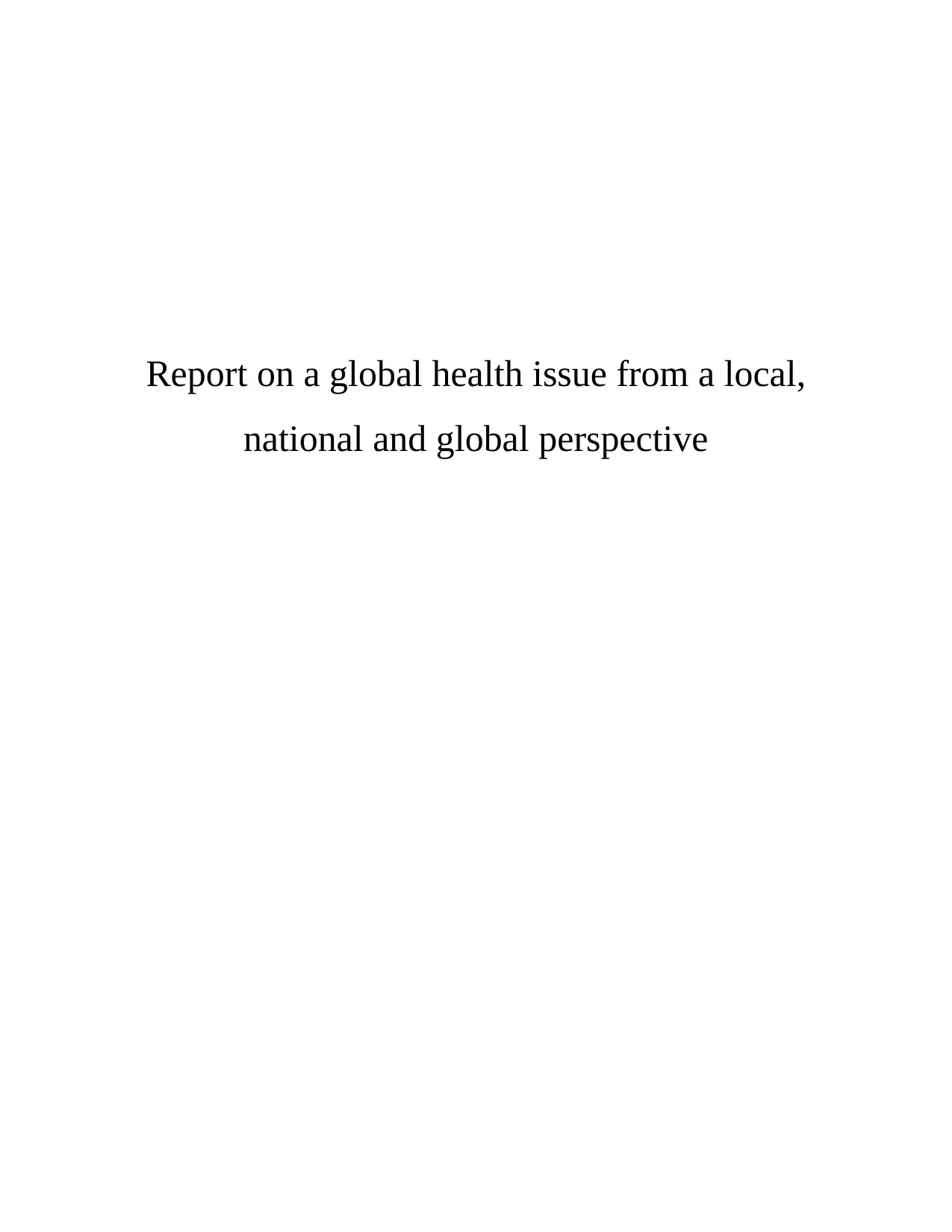
Report on a global health issue from a local,
national and global perspective
national and global perspective
Secure Best Marks with AI Grader
Need help grading? Try our AI Grader for instant feedback on your assignments.
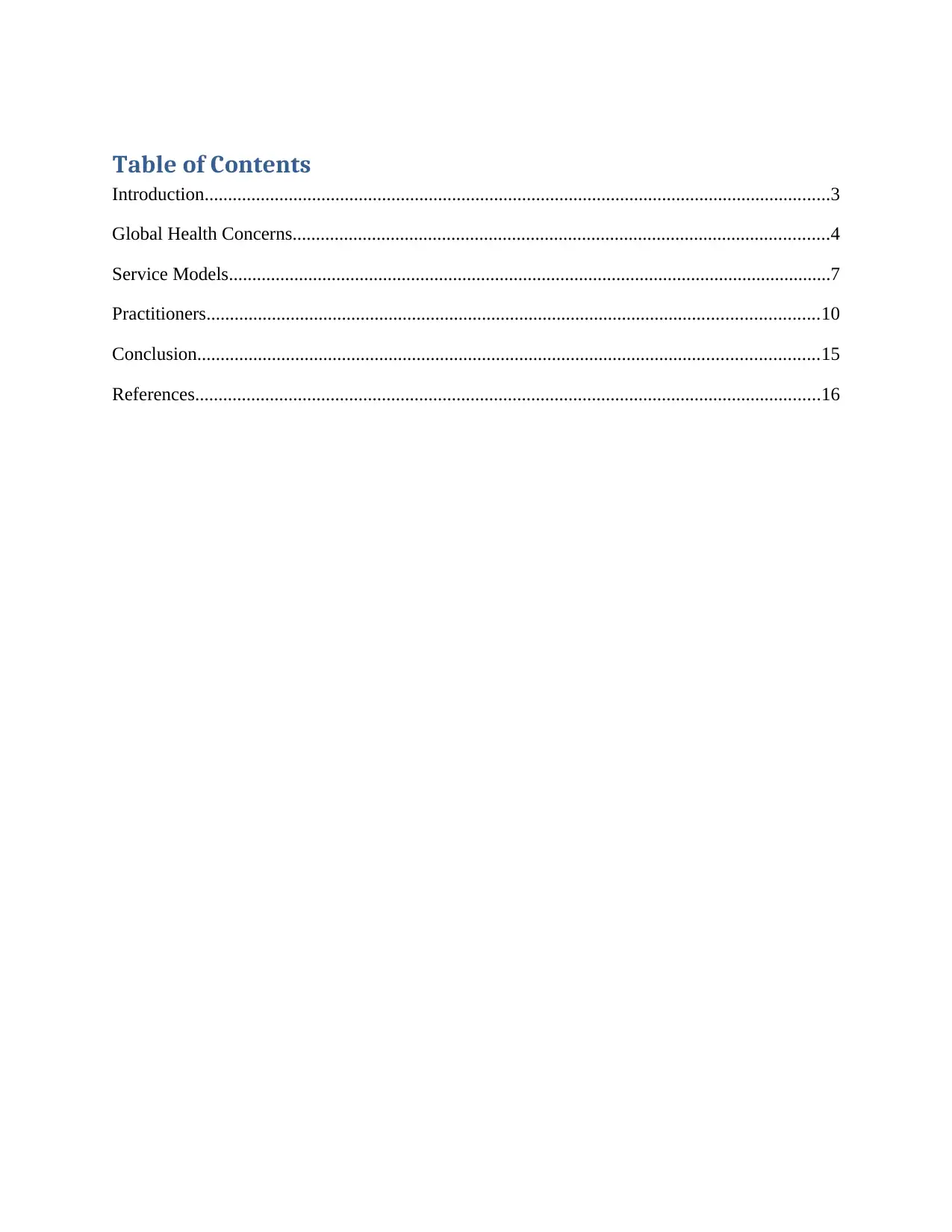
Table of Contents
Introduction......................................................................................................................................3
Global Health Concerns...................................................................................................................4
Service Models.................................................................................................................................7
Practitioners...................................................................................................................................10
Conclusion.....................................................................................................................................15
References......................................................................................................................................16
Introduction......................................................................................................................................3
Global Health Concerns...................................................................................................................4
Service Models.................................................................................................................................7
Practitioners...................................................................................................................................10
Conclusion.....................................................................................................................................15
References......................................................................................................................................16
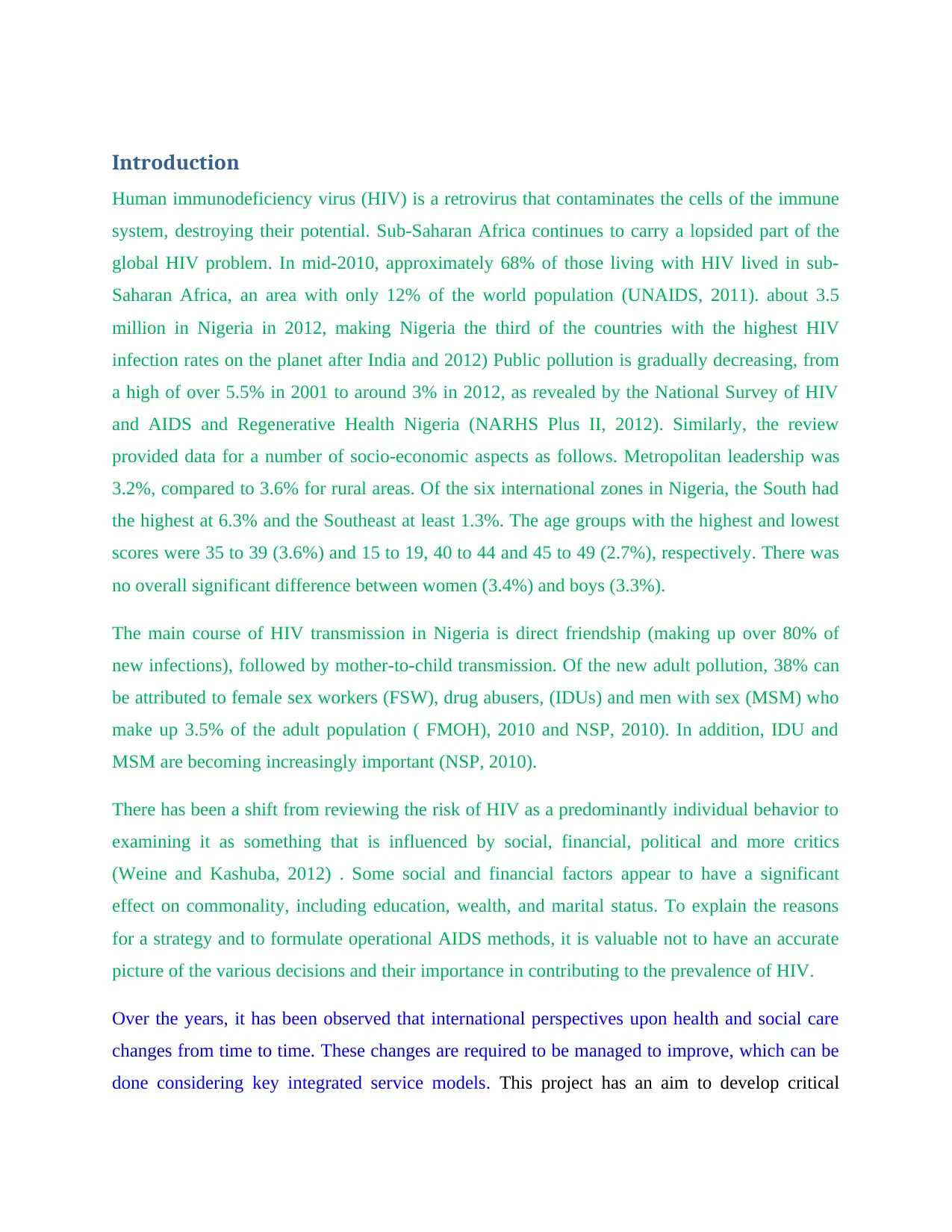
Introduction
Human immunodeficiency virus (HIV) is a retrovirus that contaminates the cells of the immune
system, destroying their potential. Sub-Saharan Africa continues to carry a lopsided part of the
global HIV problem. In mid-2010, approximately 68% of those living with HIV lived in sub-
Saharan Africa, an area with only 12% of the world population (UNAIDS, 2011). about 3.5
million in Nigeria in 2012, making Nigeria the third of the countries with the highest HIV
infection rates on the planet after India and 2012) Public pollution is gradually decreasing, from
a high of over 5.5% in 2001 to around 3% in 2012, as revealed by the National Survey of HIV
and AIDS and Regenerative Health Nigeria (NARHS Plus II, 2012). Similarly, the review
provided data for a number of socio-economic aspects as follows. Metropolitan leadership was
3.2%, compared to 3.6% for rural areas. Of the six international zones in Nigeria, the South had
the highest at 6.3% and the Southeast at least 1.3%. The age groups with the highest and lowest
scores were 35 to 39 (3.6%) and 15 to 19, 40 to 44 and 45 to 49 (2.7%), respectively. There was
no overall significant difference between women (3.4%) and boys (3.3%).
The main course of HIV transmission in Nigeria is direct friendship (making up over 80% of
new infections), followed by mother-to-child transmission. Of the new adult pollution, 38% can
be attributed to female sex workers (FSW), drug abusers, (IDUs) and men with sex (MSM) who
make up 3.5% of the adult population ( FMOH), 2010 and NSP, 2010). In addition, IDU and
MSM are becoming increasingly important (NSP, 2010).
There has been a shift from reviewing the risk of HIV as a predominantly individual behavior to
examining it as something that is influenced by social, financial, political and more critics
(Weine and Kashuba, 2012) . Some social and financial factors appear to have a significant
effect on commonality, including education, wealth, and marital status. To explain the reasons
for a strategy and to formulate operational AIDS methods, it is valuable not to have an accurate
picture of the various decisions and their importance in contributing to the prevalence of HIV.
Over the years, it has been observed that international perspectives upon health and social care
changes from time to time. These changes are required to be managed to improve, which can be
done considering key integrated service models. This project has an aim to develop critical
Human immunodeficiency virus (HIV) is a retrovirus that contaminates the cells of the immune
system, destroying their potential. Sub-Saharan Africa continues to carry a lopsided part of the
global HIV problem. In mid-2010, approximately 68% of those living with HIV lived in sub-
Saharan Africa, an area with only 12% of the world population (UNAIDS, 2011). about 3.5
million in Nigeria in 2012, making Nigeria the third of the countries with the highest HIV
infection rates on the planet after India and 2012) Public pollution is gradually decreasing, from
a high of over 5.5% in 2001 to around 3% in 2012, as revealed by the National Survey of HIV
and AIDS and Regenerative Health Nigeria (NARHS Plus II, 2012). Similarly, the review
provided data for a number of socio-economic aspects as follows. Metropolitan leadership was
3.2%, compared to 3.6% for rural areas. Of the six international zones in Nigeria, the South had
the highest at 6.3% and the Southeast at least 1.3%. The age groups with the highest and lowest
scores were 35 to 39 (3.6%) and 15 to 19, 40 to 44 and 45 to 49 (2.7%), respectively. There was
no overall significant difference between women (3.4%) and boys (3.3%).
The main course of HIV transmission in Nigeria is direct friendship (making up over 80% of
new infections), followed by mother-to-child transmission. Of the new adult pollution, 38% can
be attributed to female sex workers (FSW), drug abusers, (IDUs) and men with sex (MSM) who
make up 3.5% of the adult population ( FMOH), 2010 and NSP, 2010). In addition, IDU and
MSM are becoming increasingly important (NSP, 2010).
There has been a shift from reviewing the risk of HIV as a predominantly individual behavior to
examining it as something that is influenced by social, financial, political and more critics
(Weine and Kashuba, 2012) . Some social and financial factors appear to have a significant
effect on commonality, including education, wealth, and marital status. To explain the reasons
for a strategy and to formulate operational AIDS methods, it is valuable not to have an accurate
picture of the various decisions and their importance in contributing to the prevalence of HIV.
Over the years, it has been observed that international perspectives upon health and social care
changes from time to time. These changes are required to be managed to improve, which can be
done considering key integrated service models. This project has an aim to develop critical
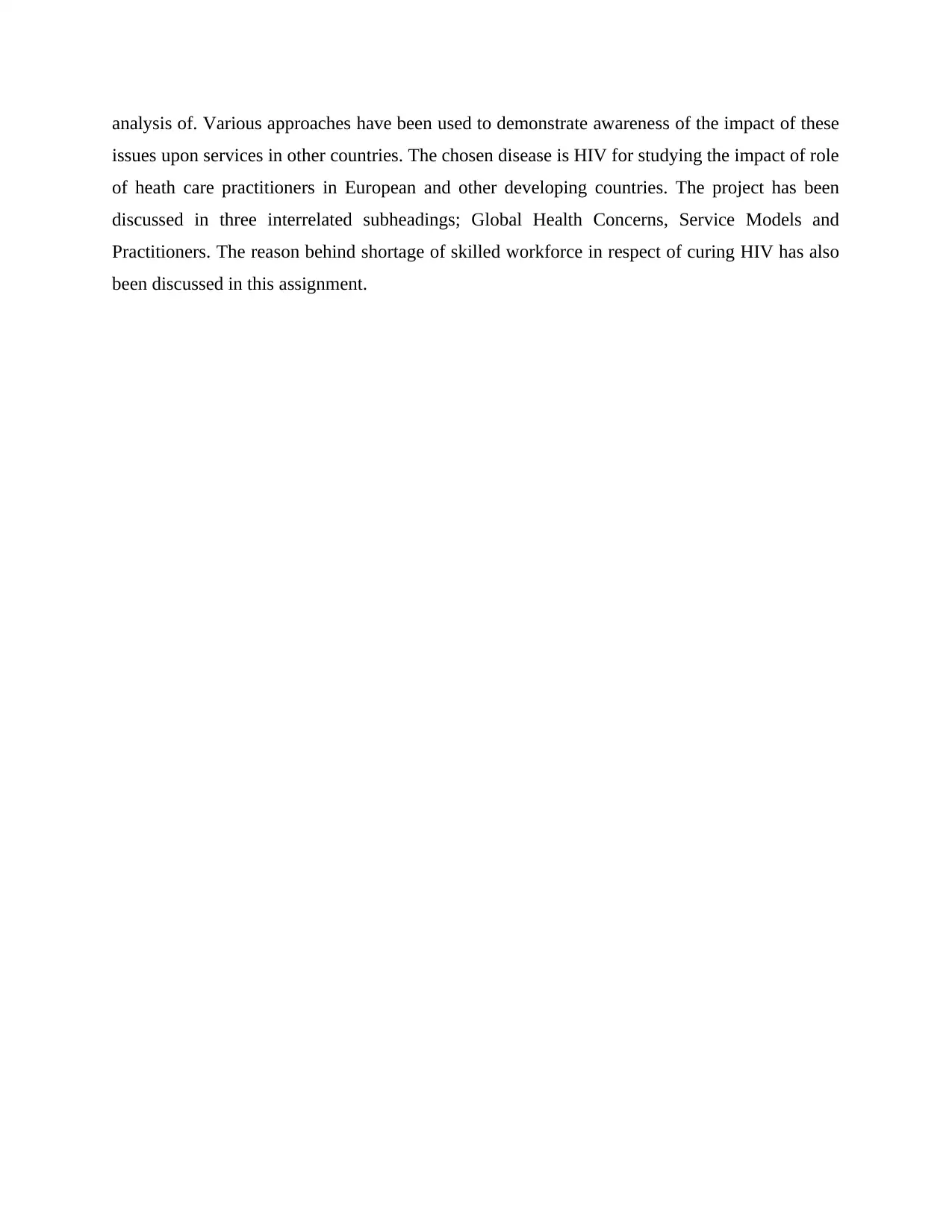
analysis of. Various approaches have been used to demonstrate awareness of the impact of these
issues upon services in other countries. The chosen disease is HIV for studying the impact of role
of heath care practitioners in European and other developing countries. The project has been
discussed in three interrelated subheadings; Global Health Concerns, Service Models and
Practitioners. The reason behind shortage of skilled workforce in respect of curing HIV has also
been discussed in this assignment.
issues upon services in other countries. The chosen disease is HIV for studying the impact of role
of heath care practitioners in European and other developing countries. The project has been
discussed in three interrelated subheadings; Global Health Concerns, Service Models and
Practitioners. The reason behind shortage of skilled workforce in respect of curing HIV has also
been discussed in this assignment.
Secure Best Marks with AI Grader
Need help grading? Try our AI Grader for instant feedback on your assignments.
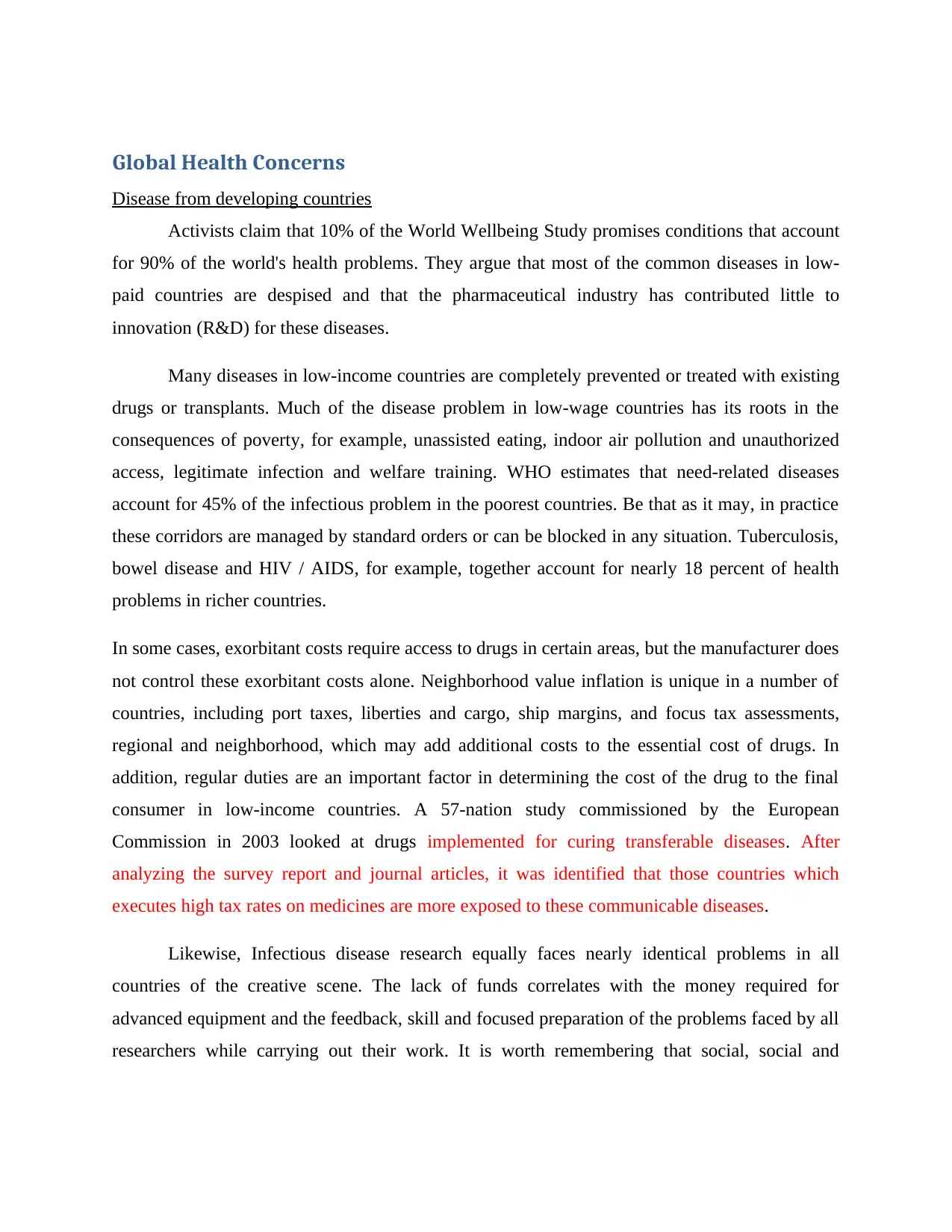
Global Health Concerns
Disease from developing countries
Activists claim that 10% of the World Wellbeing Study promises conditions that account
for 90% of the world's health problems. They argue that most of the common diseases in low-
paid countries are despised and that the pharmaceutical industry has contributed little to
innovation (R&D) for these diseases.
Many diseases in low-income countries are completely prevented or treated with existing
drugs or transplants. Much of the disease problem in low-wage countries has its roots in the
consequences of poverty, for example, unassisted eating, indoor air pollution and unauthorized
access, legitimate infection and welfare training. WHO estimates that need-related diseases
account for 45% of the infectious problem in the poorest countries. Be that as it may, in practice
these corridors are managed by standard orders or can be blocked in any situation. Tuberculosis,
bowel disease and HIV / AIDS, for example, together account for nearly 18 percent of health
problems in richer countries.
In some cases, exorbitant costs require access to drugs in certain areas, but the manufacturer does
not control these exorbitant costs alone. Neighborhood value inflation is unique in a number of
countries, including port taxes, liberties and cargo, ship margins, and focus tax assessments,
regional and neighborhood, which may add additional costs to the essential cost of drugs. In
addition, regular duties are an important factor in determining the cost of the drug to the final
consumer in low-income countries. A 57-nation study commissioned by the European
Commission in 2003 looked at drugs implemented for curing transferable diseases. After
analyzing the survey report and journal articles, it was identified that those countries which
executes high tax rates on medicines are more exposed to these communicable diseases.
Likewise, Infectious disease research equally faces nearly identical problems in all
countries of the creative scene. The lack of funds correlates with the money required for
advanced equipment and the feedback, skill and focused preparation of the problems faced by all
researchers while carrying out their work. It is worth remembering that social, social and
Disease from developing countries
Activists claim that 10% of the World Wellbeing Study promises conditions that account
for 90% of the world's health problems. They argue that most of the common diseases in low-
paid countries are despised and that the pharmaceutical industry has contributed little to
innovation (R&D) for these diseases.
Many diseases in low-income countries are completely prevented or treated with existing
drugs or transplants. Much of the disease problem in low-wage countries has its roots in the
consequences of poverty, for example, unassisted eating, indoor air pollution and unauthorized
access, legitimate infection and welfare training. WHO estimates that need-related diseases
account for 45% of the infectious problem in the poorest countries. Be that as it may, in practice
these corridors are managed by standard orders or can be blocked in any situation. Tuberculosis,
bowel disease and HIV / AIDS, for example, together account for nearly 18 percent of health
problems in richer countries.
In some cases, exorbitant costs require access to drugs in certain areas, but the manufacturer does
not control these exorbitant costs alone. Neighborhood value inflation is unique in a number of
countries, including port taxes, liberties and cargo, ship margins, and focus tax assessments,
regional and neighborhood, which may add additional costs to the essential cost of drugs. In
addition, regular duties are an important factor in determining the cost of the drug to the final
consumer in low-income countries. A 57-nation study commissioned by the European
Commission in 2003 looked at drugs implemented for curing transferable diseases. After
analyzing the survey report and journal articles, it was identified that those countries which
executes high tax rates on medicines are more exposed to these communicable diseases.
Likewise, Infectious disease research equally faces nearly identical problems in all
countries of the creative scene. The lack of funds correlates with the money required for
advanced equipment and the feedback, skill and focused preparation of the problems faced by all
researchers while carrying out their work. It is worth remembering that social, social and
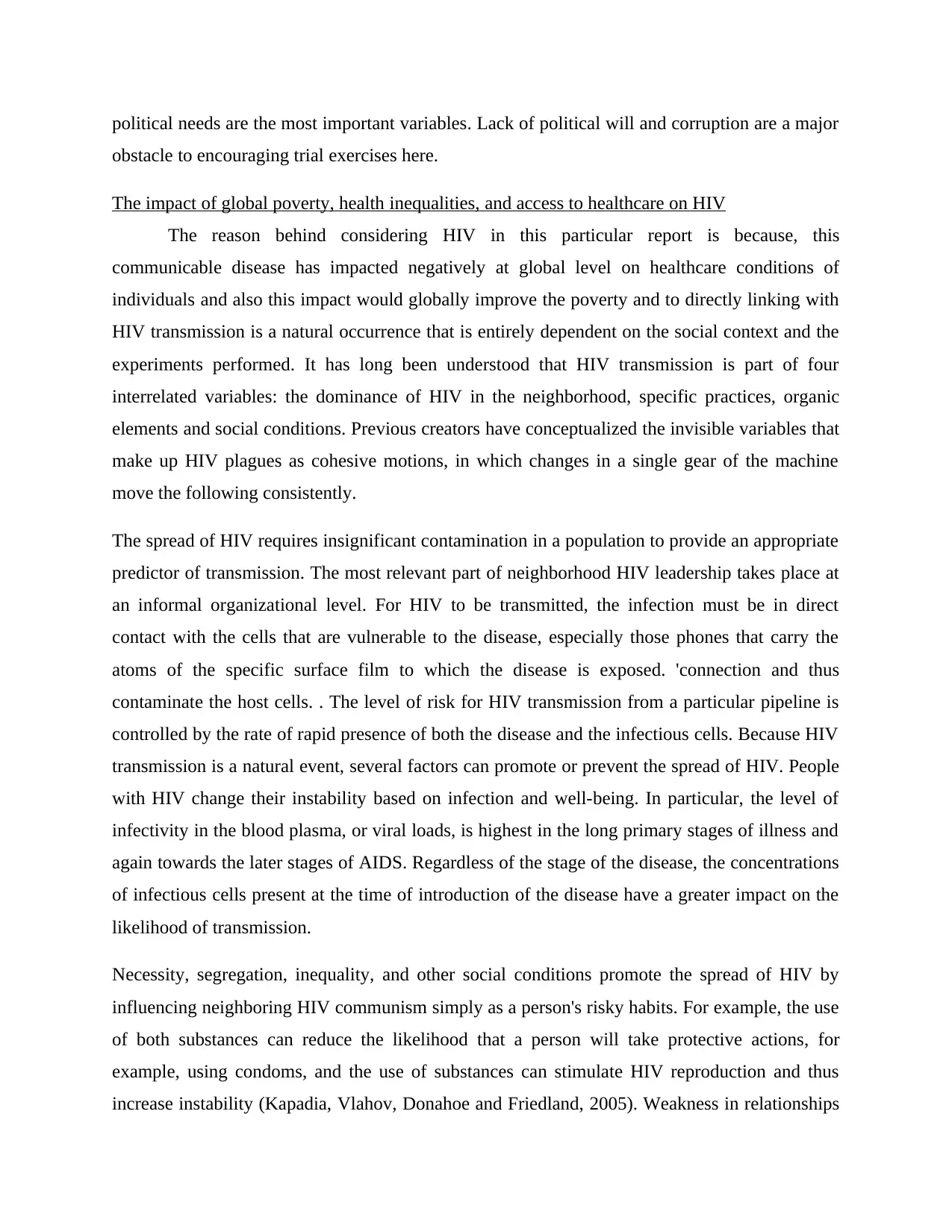
political needs are the most important variables. Lack of political will and corruption are a major
obstacle to encouraging trial exercises here.
The impact of global poverty, health inequalities, and access to healthcare on HIV
The reason behind considering HIV in this particular report is because, this
communicable disease has impacted negatively at global level on healthcare conditions of
individuals and also this impact would globally improve the poverty and to directly linking with
HIV transmission is a natural occurrence that is entirely dependent on the social context and the
experiments performed. It has long been understood that HIV transmission is part of four
interrelated variables: the dominance of HIV in the neighborhood, specific practices, organic
elements and social conditions. Previous creators have conceptualized the invisible variables that
make up HIV plagues as cohesive motions, in which changes in a single gear of the machine
move the following consistently.
The spread of HIV requires insignificant contamination in a population to provide an appropriate
predictor of transmission. The most relevant part of neighborhood HIV leadership takes place at
an informal organizational level. For HIV to be transmitted, the infection must be in direct
contact with the cells that are vulnerable to the disease, especially those phones that carry the
atoms of the specific surface film to which the disease is exposed. 'connection and thus
contaminate the host cells. . The level of risk for HIV transmission from a particular pipeline is
controlled by the rate of rapid presence of both the disease and the infectious cells. Because HIV
transmission is a natural event, several factors can promote or prevent the spread of HIV. People
with HIV change their instability based on infection and well-being. In particular, the level of
infectivity in the blood plasma, or viral loads, is highest in the long primary stages of illness and
again towards the later stages of AIDS. Regardless of the stage of the disease, the concentrations
of infectious cells present at the time of introduction of the disease have a greater impact on the
likelihood of transmission.
Necessity, segregation, inequality, and other social conditions promote the spread of HIV by
influencing neighboring HIV communism simply as a person's risky habits. For example, the use
of both substances can reduce the likelihood that a person will take protective actions, for
example, using condoms, and the use of substances can stimulate HIV reproduction and thus
increase instability (Kapadia, Vlahov, Donahoe and Friedland, 2005). Weakness in relationships
obstacle to encouraging trial exercises here.
The impact of global poverty, health inequalities, and access to healthcare on HIV
The reason behind considering HIV in this particular report is because, this
communicable disease has impacted negatively at global level on healthcare conditions of
individuals and also this impact would globally improve the poverty and to directly linking with
HIV transmission is a natural occurrence that is entirely dependent on the social context and the
experiments performed. It has long been understood that HIV transmission is part of four
interrelated variables: the dominance of HIV in the neighborhood, specific practices, organic
elements and social conditions. Previous creators have conceptualized the invisible variables that
make up HIV plagues as cohesive motions, in which changes in a single gear of the machine
move the following consistently.
The spread of HIV requires insignificant contamination in a population to provide an appropriate
predictor of transmission. The most relevant part of neighborhood HIV leadership takes place at
an informal organizational level. For HIV to be transmitted, the infection must be in direct
contact with the cells that are vulnerable to the disease, especially those phones that carry the
atoms of the specific surface film to which the disease is exposed. 'connection and thus
contaminate the host cells. . The level of risk for HIV transmission from a particular pipeline is
controlled by the rate of rapid presence of both the disease and the infectious cells. Because HIV
transmission is a natural event, several factors can promote or prevent the spread of HIV. People
with HIV change their instability based on infection and well-being. In particular, the level of
infectivity in the blood plasma, or viral loads, is highest in the long primary stages of illness and
again towards the later stages of AIDS. Regardless of the stage of the disease, the concentrations
of infectious cells present at the time of introduction of the disease have a greater impact on the
likelihood of transmission.
Necessity, segregation, inequality, and other social conditions promote the spread of HIV by
influencing neighboring HIV communism simply as a person's risky habits. For example, the use
of both substances can reduce the likelihood that a person will take protective actions, for
example, using condoms, and the use of substances can stimulate HIV reproduction and thus
increase instability (Kapadia, Vlahov, Donahoe and Friedland, 2005). Weakness in relationships
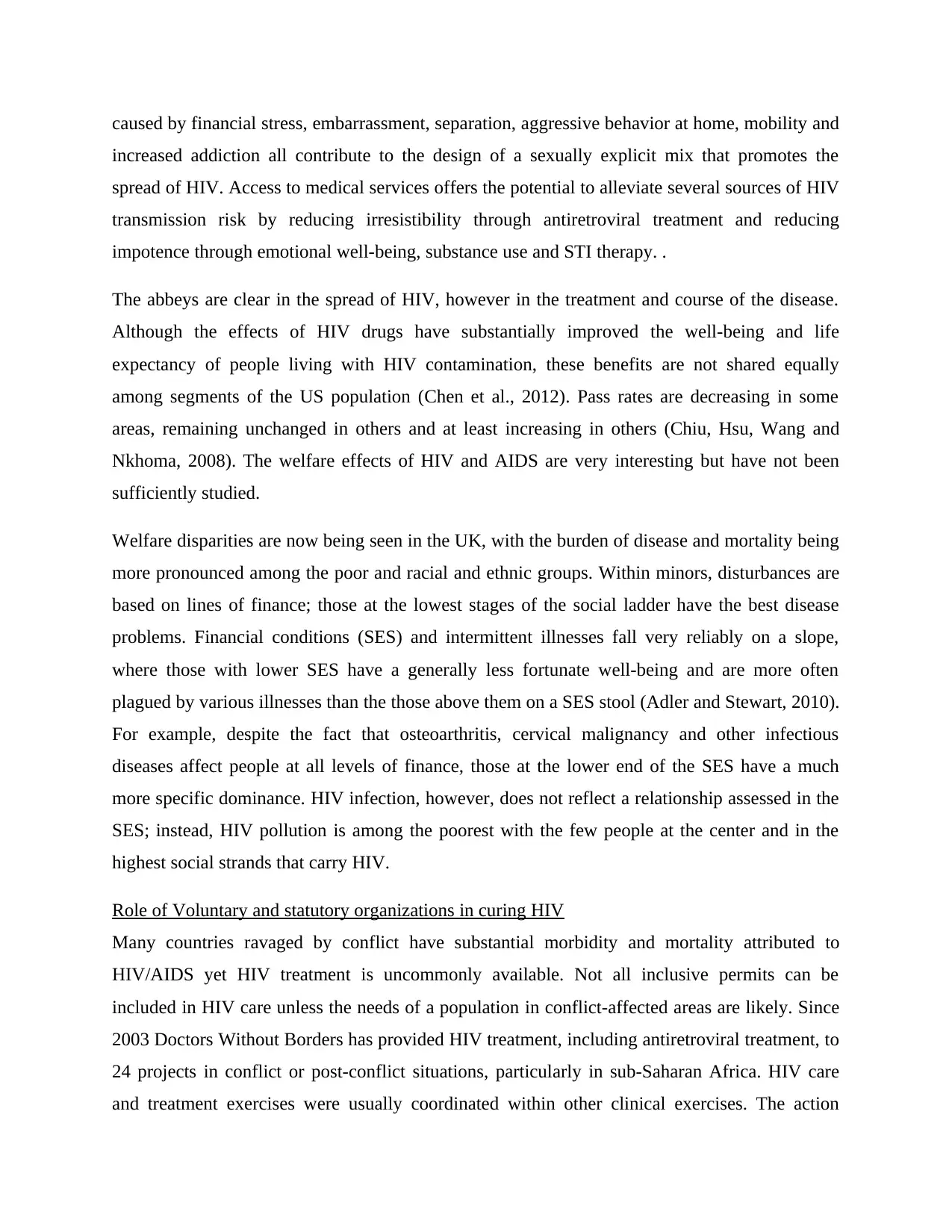
caused by financial stress, embarrassment, separation, aggressive behavior at home, mobility and
increased addiction all contribute to the design of a sexually explicit mix that promotes the
spread of HIV. Access to medical services offers the potential to alleviate several sources of HIV
transmission risk by reducing irresistibility through antiretroviral treatment and reducing
impotence through emotional well-being, substance use and STI therapy. .
The abbeys are clear in the spread of HIV, however in the treatment and course of the disease.
Although the effects of HIV drugs have substantially improved the well-being and life
expectancy of people living with HIV contamination, these benefits are not shared equally
among segments of the US population (Chen et al., 2012). Pass rates are decreasing in some
areas, remaining unchanged in others and at least increasing in others (Chiu, Hsu, Wang and
Nkhoma, 2008). The welfare effects of HIV and AIDS are very interesting but have not been
sufficiently studied.
Welfare disparities are now being seen in the UK, with the burden of disease and mortality being
more pronounced among the poor and racial and ethnic groups. Within minors, disturbances are
based on lines of finance; those at the lowest stages of the social ladder have the best disease
problems. Financial conditions (SES) and intermittent illnesses fall very reliably on a slope,
where those with lower SES have a generally less fortunate well-being and are more often
plagued by various illnesses than the those above them on a SES stool (Adler and Stewart, 2010).
For example, despite the fact that osteoarthritis, cervical malignancy and other infectious
diseases affect people at all levels of finance, those at the lower end of the SES have a much
more specific dominance. HIV infection, however, does not reflect a relationship assessed in the
SES; instead, HIV pollution is among the poorest with the few people at the center and in the
highest social strands that carry HIV.
Role of Voluntary and statutory organizations in curing HIV
Many countries ravaged by conflict have substantial morbidity and mortality attributed to
HIV/AIDS yet HIV treatment is uncommonly available. Not all inclusive permits can be
included in HIV care unless the needs of a population in conflict-affected areas are likely. Since
2003 Doctors Without Borders has provided HIV treatment, including antiretroviral treatment, to
24 projects in conflict or post-conflict situations, particularly in sub-Saharan Africa. HIV care
and treatment exercises were usually coordinated within other clinical exercises. The action
increased addiction all contribute to the design of a sexually explicit mix that promotes the
spread of HIV. Access to medical services offers the potential to alleviate several sources of HIV
transmission risk by reducing irresistibility through antiretroviral treatment and reducing
impotence through emotional well-being, substance use and STI therapy. .
The abbeys are clear in the spread of HIV, however in the treatment and course of the disease.
Although the effects of HIV drugs have substantially improved the well-being and life
expectancy of people living with HIV contamination, these benefits are not shared equally
among segments of the US population (Chen et al., 2012). Pass rates are decreasing in some
areas, remaining unchanged in others and at least increasing in others (Chiu, Hsu, Wang and
Nkhoma, 2008). The welfare effects of HIV and AIDS are very interesting but have not been
sufficiently studied.
Welfare disparities are now being seen in the UK, with the burden of disease and mortality being
more pronounced among the poor and racial and ethnic groups. Within minors, disturbances are
based on lines of finance; those at the lowest stages of the social ladder have the best disease
problems. Financial conditions (SES) and intermittent illnesses fall very reliably on a slope,
where those with lower SES have a generally less fortunate well-being and are more often
plagued by various illnesses than the those above them on a SES stool (Adler and Stewart, 2010).
For example, despite the fact that osteoarthritis, cervical malignancy and other infectious
diseases affect people at all levels of finance, those at the lower end of the SES have a much
more specific dominance. HIV infection, however, does not reflect a relationship assessed in the
SES; instead, HIV pollution is among the poorest with the few people at the center and in the
highest social strands that carry HIV.
Role of Voluntary and statutory organizations in curing HIV
Many countries ravaged by conflict have substantial morbidity and mortality attributed to
HIV/AIDS yet HIV treatment is uncommonly available. Not all inclusive permits can be
included in HIV care unless the needs of a population in conflict-affected areas are likely. Since
2003 Doctors Without Borders has provided HIV treatment, including antiretroviral treatment, to
24 projects in conflict or post-conflict situations, particularly in sub-Saharan Africa. HIV care
and treatment exercises were usually coordinated within other clinical exercises. The action
Paraphrase This Document
Need a fresh take? Get an instant paraphrase of this document with our AI Paraphraser
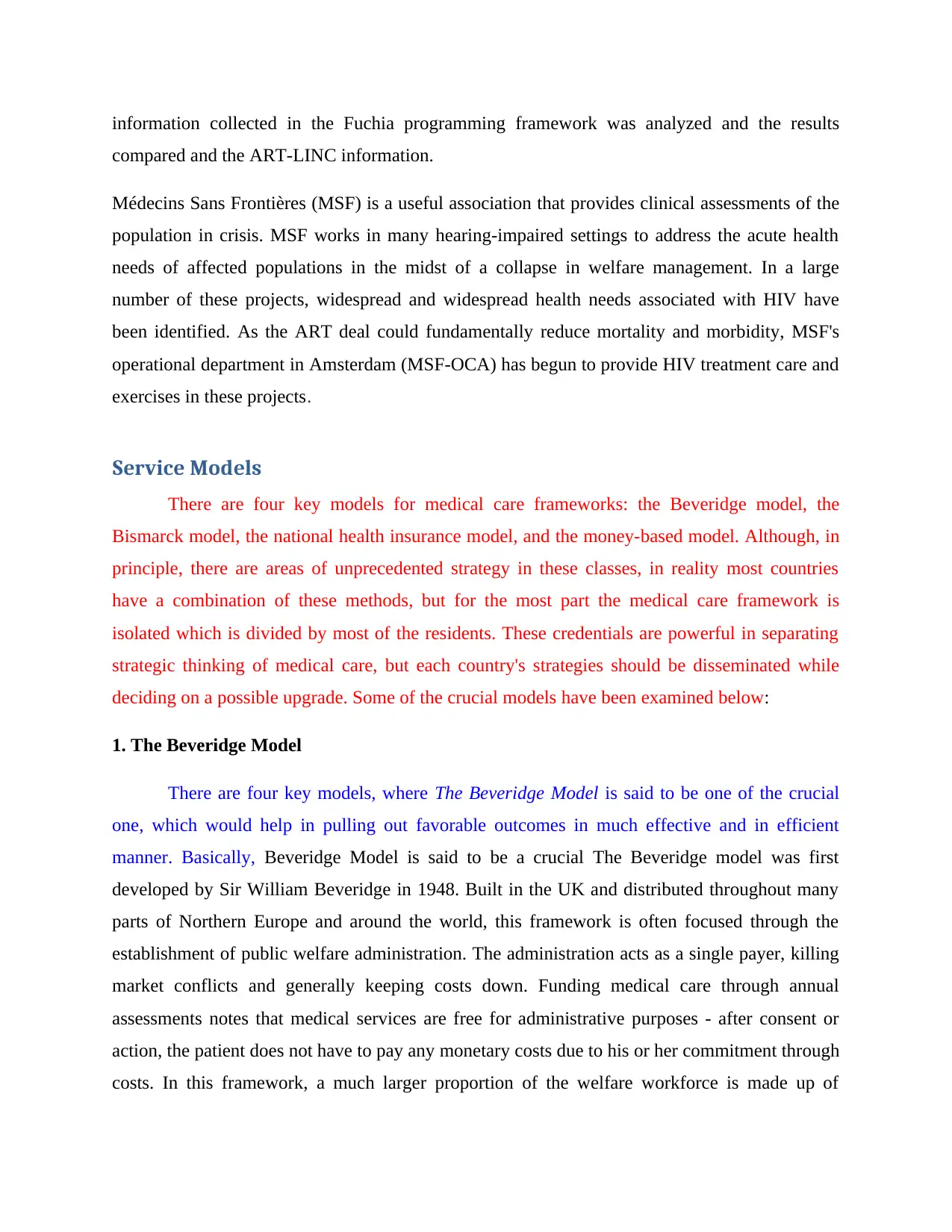
information collected in the Fuchia programming framework was analyzed and the results
compared and the ART-LINC information.
Médecins Sans Frontières (MSF) is a useful association that provides clinical assessments of the
population in crisis. MSF works in many hearing-impaired settings to address the acute health
needs of affected populations in the midst of a collapse in welfare management. In a large
number of these projects, widespread and widespread health needs associated with HIV have
been identified. As the ART deal could fundamentally reduce mortality and morbidity, MSF's
operational department in Amsterdam (MSF-OCA) has begun to provide HIV treatment care and
exercises in these projects.
Service Models
There are four key models for medical care frameworks: the Beveridge model, the
Bismarck model, the national health insurance model, and the money-based model. Although, in
principle, there are areas of unprecedented strategy in these classes, in reality most countries
have a combination of these methods, but for the most part the medical care framework is
isolated which is divided by most of the residents. These credentials are powerful in separating
strategic thinking of medical care, but each country's strategies should be disseminated while
deciding on a possible upgrade. Some of the crucial models have been examined below:
1. The Beveridge Model
There are four key models, where The Beveridge Model is said to be one of the crucial
one, which would help in pulling out favorable outcomes in much effective and in efficient
manner. Basically, Beveridge Model is said to be a crucial The Beveridge model was first
developed by Sir William Beveridge in 1948. Built in the UK and distributed throughout many
parts of Northern Europe and around the world, this framework is often focused through the
establishment of public welfare administration. The administration acts as a single payer, killing
market conflicts and generally keeping costs down. Funding medical care through annual
assessments notes that medical services are free for administrative purposes - after consent or
action, the patient does not have to pay any monetary costs due to his or her commitment through
costs. In this framework, a much larger proportion of the welfare workforce is made up of
compared and the ART-LINC information.
Médecins Sans Frontières (MSF) is a useful association that provides clinical assessments of the
population in crisis. MSF works in many hearing-impaired settings to address the acute health
needs of affected populations in the midst of a collapse in welfare management. In a large
number of these projects, widespread and widespread health needs associated with HIV have
been identified. As the ART deal could fundamentally reduce mortality and morbidity, MSF's
operational department in Amsterdam (MSF-OCA) has begun to provide HIV treatment care and
exercises in these projects.
Service Models
There are four key models for medical care frameworks: the Beveridge model, the
Bismarck model, the national health insurance model, and the money-based model. Although, in
principle, there are areas of unprecedented strategy in these classes, in reality most countries
have a combination of these methods, but for the most part the medical care framework is
isolated which is divided by most of the residents. These credentials are powerful in separating
strategic thinking of medical care, but each country's strategies should be disseminated while
deciding on a possible upgrade. Some of the crucial models have been examined below:
1. The Beveridge Model
There are four key models, where The Beveridge Model is said to be one of the crucial
one, which would help in pulling out favorable outcomes in much effective and in efficient
manner. Basically, Beveridge Model is said to be a crucial The Beveridge model was first
developed by Sir William Beveridge in 1948. Built in the UK and distributed throughout many
parts of Northern Europe and around the world, this framework is often focused through the
establishment of public welfare administration. The administration acts as a single payer, killing
market conflicts and generally keeping costs down. Funding medical care through annual
assessments notes that medical services are free for administrative purposes - after consent or
action, the patient does not have to pay any monetary costs due to his or her commitment through
costs. In this framework, a much larger proportion of the welfare workforce is made up of
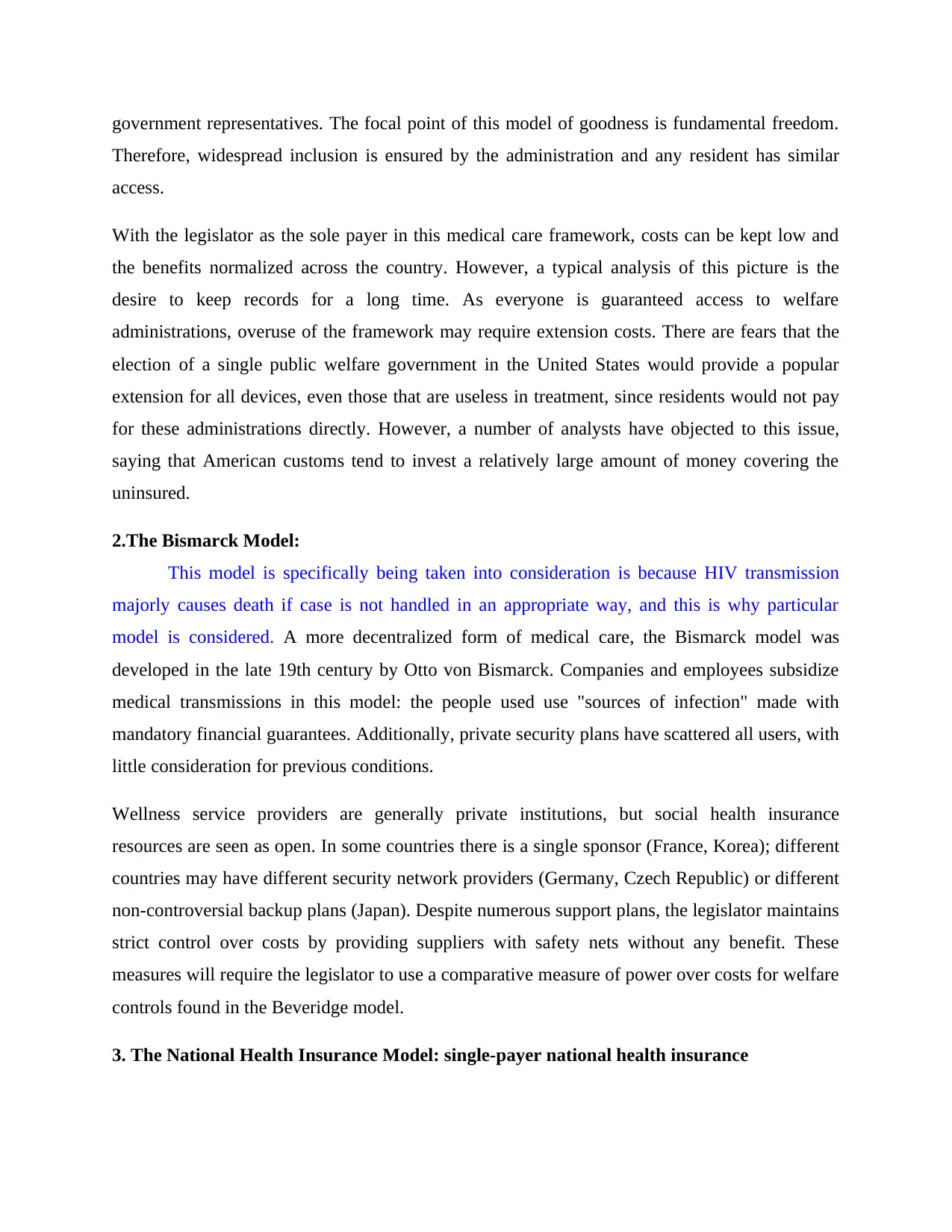
government representatives. The focal point of this model of goodness is fundamental freedom.
Therefore, widespread inclusion is ensured by the administration and any resident has similar
access.
With the legislator as the sole payer in this medical care framework, costs can be kept low and
the benefits normalized across the country. However, a typical analysis of this picture is the
desire to keep records for a long time. As everyone is guaranteed access to welfare
administrations, overuse of the framework may require extension costs. There are fears that the
election of a single public welfare government in the United States would provide a popular
extension for all devices, even those that are useless in treatment, since residents would not pay
for these administrations directly. However, a number of analysts have objected to this issue,
saying that American customs tend to invest a relatively large amount of money covering the
uninsured.
2.The Bismarck Model:
This model is specifically being taken into consideration is because HIV transmission
majorly causes death if case is not handled in an appropriate way, and this is why particular
model is considered. A more decentralized form of medical care, the Bismarck model was
developed in the late 19th century by Otto von Bismarck. Companies and employees subsidize
medical transmissions in this model: the people used use "sources of infection" made with
mandatory financial guarantees. Additionally, private security plans have scattered all users, with
little consideration for previous conditions.
Wellness service providers are generally private institutions, but social health insurance
resources are seen as open. In some countries there is a single sponsor (France, Korea); different
countries may have different security network providers (Germany, Czech Republic) or different
non-controversial backup plans (Japan). Despite numerous support plans, the legislator maintains
strict control over costs by providing suppliers with safety nets without any benefit. These
measures will require the legislator to use a comparative measure of power over costs for welfare
controls found in the Beveridge model.
3. The National Health Insurance Model: single-payer national health insurance
Therefore, widespread inclusion is ensured by the administration and any resident has similar
access.
With the legislator as the sole payer in this medical care framework, costs can be kept low and
the benefits normalized across the country. However, a typical analysis of this picture is the
desire to keep records for a long time. As everyone is guaranteed access to welfare
administrations, overuse of the framework may require extension costs. There are fears that the
election of a single public welfare government in the United States would provide a popular
extension for all devices, even those that are useless in treatment, since residents would not pay
for these administrations directly. However, a number of analysts have objected to this issue,
saying that American customs tend to invest a relatively large amount of money covering the
uninsured.
2.The Bismarck Model:
This model is specifically being taken into consideration is because HIV transmission
majorly causes death if case is not handled in an appropriate way, and this is why particular
model is considered. A more decentralized form of medical care, the Bismarck model was
developed in the late 19th century by Otto von Bismarck. Companies and employees subsidize
medical transmissions in this model: the people used use "sources of infection" made with
mandatory financial guarantees. Additionally, private security plans have scattered all users, with
little consideration for previous conditions.
Wellness service providers are generally private institutions, but social health insurance
resources are seen as open. In some countries there is a single sponsor (France, Korea); different
countries may have different security network providers (Germany, Czech Republic) or different
non-controversial backup plans (Japan). Despite numerous support plans, the legislator maintains
strict control over costs by providing suppliers with safety nets without any benefit. These
measures will require the legislator to use a comparative measure of power over costs for welfare
controls found in the Beveridge model.
3. The National Health Insurance Model: single-payer national health insurance
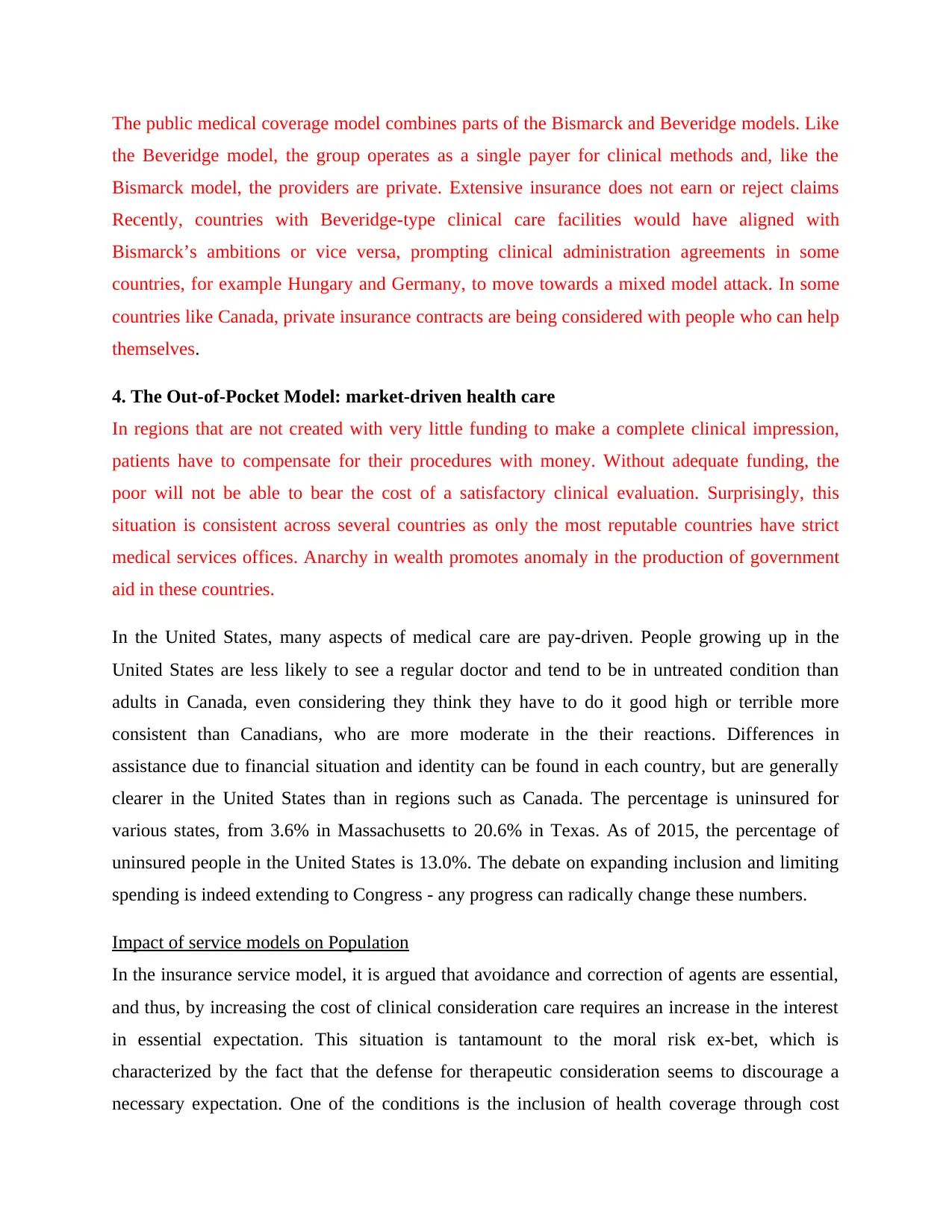
The public medical coverage model combines parts of the Bismarck and Beveridge models. Like
the Beveridge model, the group operates as a single payer for clinical methods and, like the
Bismarck model, the providers are private. Extensive insurance does not earn or reject claims
Recently, countries with Beveridge-type clinical care facilities would have aligned with
Bismarck’s ambitions or vice versa, prompting clinical administration agreements in some
countries, for example Hungary and Germany, to move towards a mixed model attack. In some
countries like Canada, private insurance contracts are being considered with people who can help
themselves.
4. The Out-of-Pocket Model: market-driven health care
In regions that are not created with very little funding to make a complete clinical impression,
patients have to compensate for their procedures with money. Without adequate funding, the
poor will not be able to bear the cost of a satisfactory clinical evaluation. Surprisingly, this
situation is consistent across several countries as only the most reputable countries have strict
medical services offices. Anarchy in wealth promotes anomaly in the production of government
aid in these countries.
In the United States, many aspects of medical care are pay-driven. People growing up in the
United States are less likely to see a regular doctor and tend to be in untreated condition than
adults in Canada, even considering they think they have to do it good high or terrible more
consistent than Canadians, who are more moderate in the their reactions. Differences in
assistance due to financial situation and identity can be found in each country, but are generally
clearer in the United States than in regions such as Canada. The percentage is uninsured for
various states, from 3.6% in Massachusetts to 20.6% in Texas. As of 2015, the percentage of
uninsured people in the United States is 13.0%. The debate on expanding inclusion and limiting
spending is indeed extending to Congress - any progress can radically change these numbers.
Impact of service models on Population
In the insurance service model, it is argued that avoidance and correction of agents are essential,
and thus, by increasing the cost of clinical consideration care requires an increase in the interest
in essential expectation. This situation is tantamount to the moral risk ex-bet, which is
characterized by the fact that the defense for therapeutic consideration seems to discourage a
necessary expectation. One of the conditions is the inclusion of health coverage through cost
the Beveridge model, the group operates as a single payer for clinical methods and, like the
Bismarck model, the providers are private. Extensive insurance does not earn or reject claims
Recently, countries with Beveridge-type clinical care facilities would have aligned with
Bismarck’s ambitions or vice versa, prompting clinical administration agreements in some
countries, for example Hungary and Germany, to move towards a mixed model attack. In some
countries like Canada, private insurance contracts are being considered with people who can help
themselves.
4. The Out-of-Pocket Model: market-driven health care
In regions that are not created with very little funding to make a complete clinical impression,
patients have to compensate for their procedures with money. Without adequate funding, the
poor will not be able to bear the cost of a satisfactory clinical evaluation. Surprisingly, this
situation is consistent across several countries as only the most reputable countries have strict
medical services offices. Anarchy in wealth promotes anomaly in the production of government
aid in these countries.
In the United States, many aspects of medical care are pay-driven. People growing up in the
United States are less likely to see a regular doctor and tend to be in untreated condition than
adults in Canada, even considering they think they have to do it good high or terrible more
consistent than Canadians, who are more moderate in the their reactions. Differences in
assistance due to financial situation and identity can be found in each country, but are generally
clearer in the United States than in regions such as Canada. The percentage is uninsured for
various states, from 3.6% in Massachusetts to 20.6% in Texas. As of 2015, the percentage of
uninsured people in the United States is 13.0%. The debate on expanding inclusion and limiting
spending is indeed extending to Congress - any progress can radically change these numbers.
Impact of service models on Population
In the insurance service model, it is argued that avoidance and correction of agents are essential,
and thus, by increasing the cost of clinical consideration care requires an increase in the interest
in essential expectation. This situation is tantamount to the moral risk ex-bet, which is
characterized by the fact that the defense for therapeutic consideration seems to discourage a
necessary expectation. One of the conditions is the inclusion of health coverage through cost
Secure Best Marks with AI Grader
Need help grading? Try our AI Grader for instant feedback on your assignments.
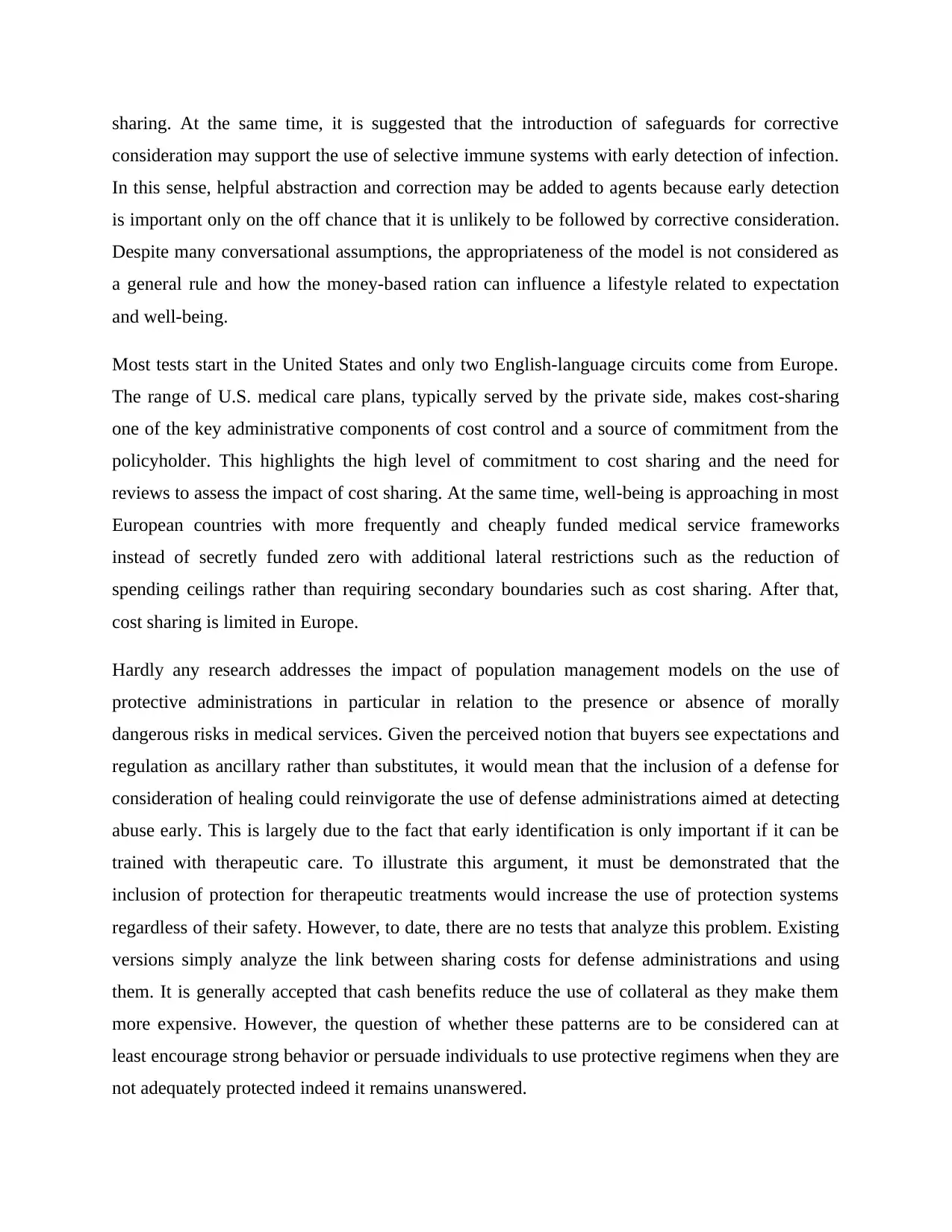
sharing. At the same time, it is suggested that the introduction of safeguards for corrective
consideration may support the use of selective immune systems with early detection of infection.
In this sense, helpful abstraction and correction may be added to agents because early detection
is important only on the off chance that it is unlikely to be followed by corrective consideration.
Despite many conversational assumptions, the appropriateness of the model is not considered as
a general rule and how the money-based ration can influence a lifestyle related to expectation
and well-being.
Most tests start in the United States and only two English-language circuits come from Europe.
The range of U.S. medical care plans, typically served by the private side, makes cost-sharing
one of the key administrative components of cost control and a source of commitment from the
policyholder. This highlights the high level of commitment to cost sharing and the need for
reviews to assess the impact of cost sharing. At the same time, well-being is approaching in most
European countries with more frequently and cheaply funded medical service frameworks
instead of secretly funded zero with additional lateral restrictions such as the reduction of
spending ceilings rather than requiring secondary boundaries such as cost sharing. After that,
cost sharing is limited in Europe.
Hardly any research addresses the impact of population management models on the use of
protective administrations in particular in relation to the presence or absence of morally
dangerous risks in medical services. Given the perceived notion that buyers see expectations and
regulation as ancillary rather than substitutes, it would mean that the inclusion of a defense for
consideration of healing could reinvigorate the use of defense administrations aimed at detecting
abuse early. This is largely due to the fact that early identification is only important if it can be
trained with therapeutic care. To illustrate this argument, it must be demonstrated that the
inclusion of protection for therapeutic treatments would increase the use of protection systems
regardless of their safety. However, to date, there are no tests that analyze this problem. Existing
versions simply analyze the link between sharing costs for defense administrations and using
them. It is generally accepted that cash benefits reduce the use of collateral as they make them
more expensive. However, the question of whether these patterns are to be considered can at
least encourage strong behavior or persuade individuals to use protective regimens when they are
not adequately protected indeed it remains unanswered.
consideration may support the use of selective immune systems with early detection of infection.
In this sense, helpful abstraction and correction may be added to agents because early detection
is important only on the off chance that it is unlikely to be followed by corrective consideration.
Despite many conversational assumptions, the appropriateness of the model is not considered as
a general rule and how the money-based ration can influence a lifestyle related to expectation
and well-being.
Most tests start in the United States and only two English-language circuits come from Europe.
The range of U.S. medical care plans, typically served by the private side, makes cost-sharing
one of the key administrative components of cost control and a source of commitment from the
policyholder. This highlights the high level of commitment to cost sharing and the need for
reviews to assess the impact of cost sharing. At the same time, well-being is approaching in most
European countries with more frequently and cheaply funded medical service frameworks
instead of secretly funded zero with additional lateral restrictions such as the reduction of
spending ceilings rather than requiring secondary boundaries such as cost sharing. After that,
cost sharing is limited in Europe.
Hardly any research addresses the impact of population management models on the use of
protective administrations in particular in relation to the presence or absence of morally
dangerous risks in medical services. Given the perceived notion that buyers see expectations and
regulation as ancillary rather than substitutes, it would mean that the inclusion of a defense for
consideration of healing could reinvigorate the use of defense administrations aimed at detecting
abuse early. This is largely due to the fact that early identification is only important if it can be
trained with therapeutic care. To illustrate this argument, it must be demonstrated that the
inclusion of protection for therapeutic treatments would increase the use of protection systems
regardless of their safety. However, to date, there are no tests that analyze this problem. Existing
versions simply analyze the link between sharing costs for defense administrations and using
them. It is generally accepted that cash benefits reduce the use of collateral as they make them
more expensive. However, the question of whether these patterns are to be considered can at
least encourage strong behavior or persuade individuals to use protective regimens when they are
not adequately protected indeed it remains unanswered.
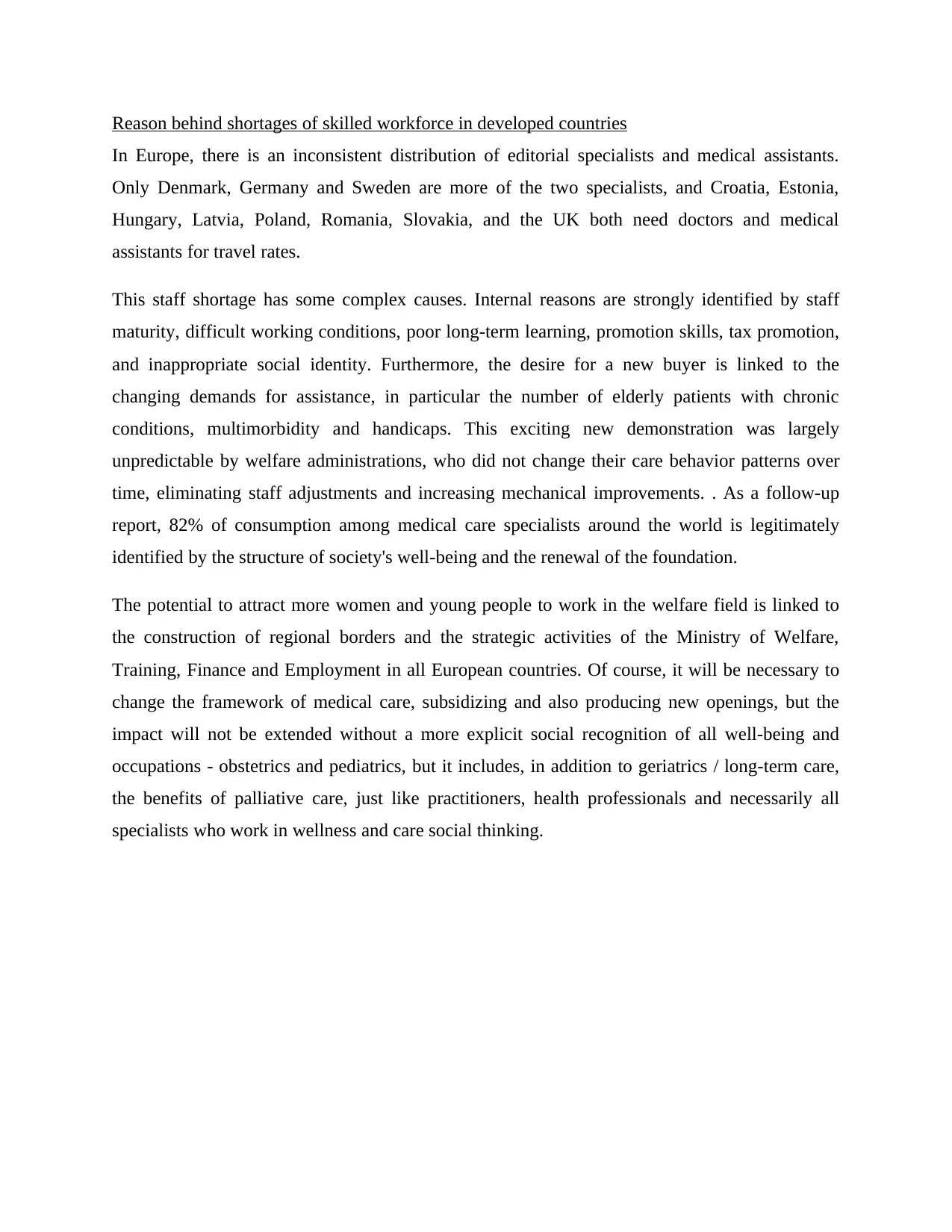
Reason behind shortages of skilled workforce in developed countries
In Europe, there is an inconsistent distribution of editorial specialists and medical assistants.
Only Denmark, Germany and Sweden are more of the two specialists, and Croatia, Estonia,
Hungary, Latvia, Poland, Romania, Slovakia, and the UK both need doctors and medical
assistants for travel rates.
This staff shortage has some complex causes. Internal reasons are strongly identified by staff
maturity, difficult working conditions, poor long-term learning, promotion skills, tax promotion,
and inappropriate social identity. Furthermore, the desire for a new buyer is linked to the
changing demands for assistance, in particular the number of elderly patients with chronic
conditions, multimorbidity and handicaps. This exciting new demonstration was largely
unpredictable by welfare administrations, who did not change their care behavior patterns over
time, eliminating staff adjustments and increasing mechanical improvements. . As a follow-up
report, 82% of consumption among medical care specialists around the world is legitimately
identified by the structure of society's well-being and the renewal of the foundation.
The potential to attract more women and young people to work in the welfare field is linked to
the construction of regional borders and the strategic activities of the Ministry of Welfare,
Training, Finance and Employment in all European countries. Of course, it will be necessary to
change the framework of medical care, subsidizing and also producing new openings, but the
impact will not be extended without a more explicit social recognition of all well-being and
occupations - obstetrics and pediatrics, but it includes, in addition to geriatrics / long-term care,
the benefits of palliative care, just like practitioners, health professionals and necessarily all
specialists who work in wellness and care social thinking.
In Europe, there is an inconsistent distribution of editorial specialists and medical assistants.
Only Denmark, Germany and Sweden are more of the two specialists, and Croatia, Estonia,
Hungary, Latvia, Poland, Romania, Slovakia, and the UK both need doctors and medical
assistants for travel rates.
This staff shortage has some complex causes. Internal reasons are strongly identified by staff
maturity, difficult working conditions, poor long-term learning, promotion skills, tax promotion,
and inappropriate social identity. Furthermore, the desire for a new buyer is linked to the
changing demands for assistance, in particular the number of elderly patients with chronic
conditions, multimorbidity and handicaps. This exciting new demonstration was largely
unpredictable by welfare administrations, who did not change their care behavior patterns over
time, eliminating staff adjustments and increasing mechanical improvements. . As a follow-up
report, 82% of consumption among medical care specialists around the world is legitimately
identified by the structure of society's well-being and the renewal of the foundation.
The potential to attract more women and young people to work in the welfare field is linked to
the construction of regional borders and the strategic activities of the Ministry of Welfare,
Training, Finance and Employment in all European countries. Of course, it will be necessary to
change the framework of medical care, subsidizing and also producing new openings, but the
impact will not be extended without a more explicit social recognition of all well-being and
occupations - obstetrics and pediatrics, but it includes, in addition to geriatrics / long-term care,
the benefits of palliative care, just like practitioners, health professionals and necessarily all
specialists who work in wellness and care social thinking.
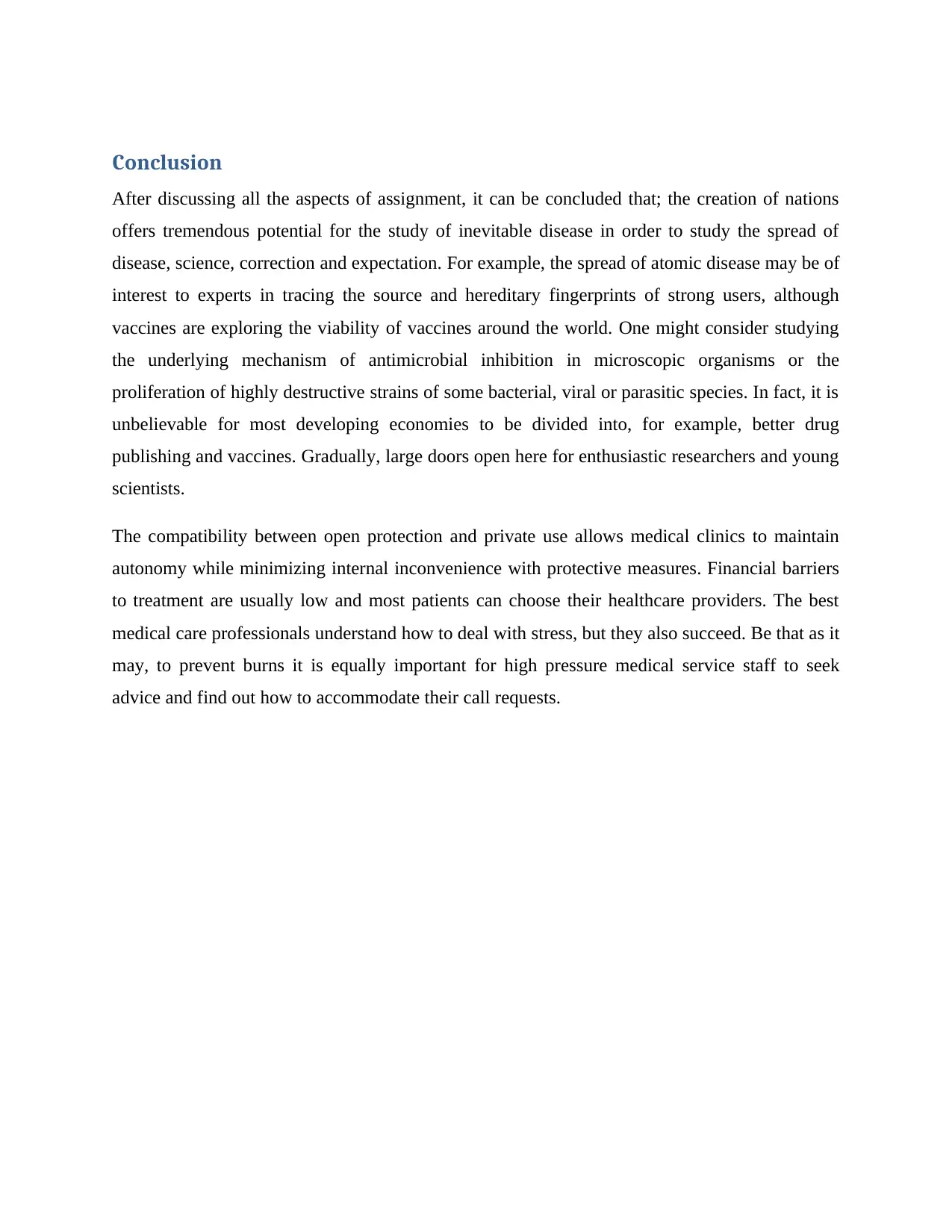
Conclusion
After discussing all the aspects of assignment, it can be concluded that; the creation of nations
offers tremendous potential for the study of inevitable disease in order to study the spread of
disease, science, correction and expectation. For example, the spread of atomic disease may be of
interest to experts in tracing the source and hereditary fingerprints of strong users, although
vaccines are exploring the viability of vaccines around the world. One might consider studying
the underlying mechanism of antimicrobial inhibition in microscopic organisms or the
proliferation of highly destructive strains of some bacterial, viral or parasitic species. In fact, it is
unbelievable for most developing economies to be divided into, for example, better drug
publishing and vaccines. Gradually, large doors open here for enthusiastic researchers and young
scientists.
The compatibility between open protection and private use allows medical clinics to maintain
autonomy while minimizing internal inconvenience with protective measures. Financial barriers
to treatment are usually low and most patients can choose their healthcare providers. The best
medical care professionals understand how to deal with stress, but they also succeed. Be that as it
may, to prevent burns it is equally important for high pressure medical service staff to seek
advice and find out how to accommodate their call requests.
After discussing all the aspects of assignment, it can be concluded that; the creation of nations
offers tremendous potential for the study of inevitable disease in order to study the spread of
disease, science, correction and expectation. For example, the spread of atomic disease may be of
interest to experts in tracing the source and hereditary fingerprints of strong users, although
vaccines are exploring the viability of vaccines around the world. One might consider studying
the underlying mechanism of antimicrobial inhibition in microscopic organisms or the
proliferation of highly destructive strains of some bacterial, viral or parasitic species. In fact, it is
unbelievable for most developing economies to be divided into, for example, better drug
publishing and vaccines. Gradually, large doors open here for enthusiastic researchers and young
scientists.
The compatibility between open protection and private use allows medical clinics to maintain
autonomy while minimizing internal inconvenience with protective measures. Financial barriers
to treatment are usually low and most patients can choose their healthcare providers. The best
medical care professionals understand how to deal with stress, but they also succeed. Be that as it
may, to prevent burns it is equally important for high pressure medical service staff to seek
advice and find out how to accommodate their call requests.
Paraphrase This Document
Need a fresh take? Get an instant paraphrase of this document with our AI Paraphraser
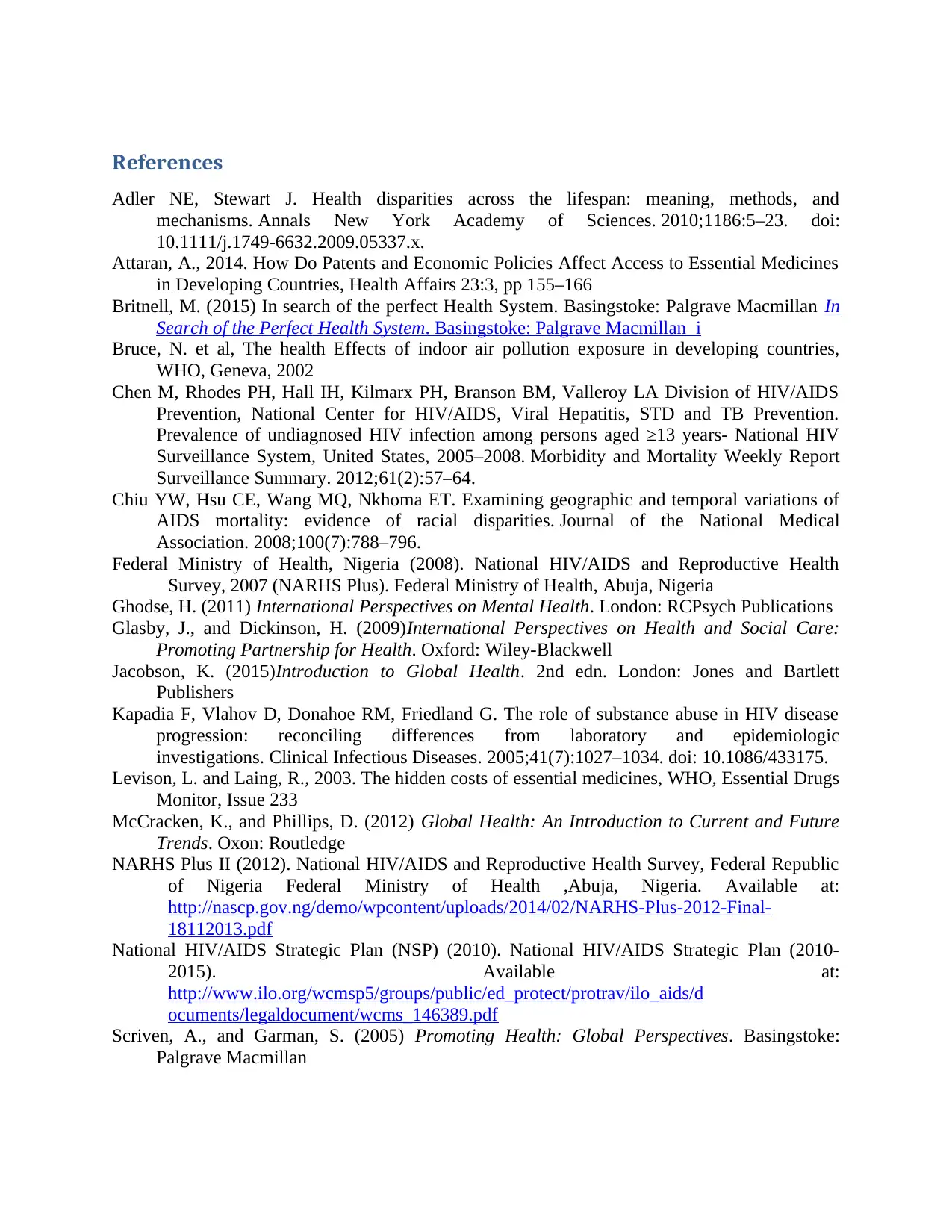
References
Adler NE, Stewart J. Health disparities across the lifespan: meaning, methods, and
mechanisms. Annals New York Academy of Sciences. 2010;1186:5–23. doi:
10.1111/j.1749-6632.2009.05337.x.
Attaran, A., 2014. How Do Patents and Economic Policies Affect Access to Essential Medicines
in Developing Countries, Health Affairs 23:3, pp 155–166
Britnell, M. (2015) In search of the perfect Health System. Basingstoke: Palgrave Macmillan In
Search of the Perfect Health System. Basingstoke: Palgrave Macmillan i
Bruce, N. et al, The health Effects of indoor air pollution exposure in developing countries,
WHO, Geneva, 2002
Chen M, Rhodes PH, Hall IH, Kilmarx PH, Branson BM, Valleroy LA Division of HIV/AIDS
Prevention, National Center for HIV/AIDS, Viral Hepatitis, STD and TB Prevention.
Prevalence of undiagnosed HIV infection among persons aged ≥13 years- National HIV
Surveillance System, United States, 2005–2008. Morbidity and Mortality Weekly Report
Surveillance Summary. 2012;61(2):57–64.
Chiu YW, Hsu CE, Wang MQ, Nkhoma ET. Examining geographic and temporal variations of
AIDS mortality: evidence of racial disparities. Journal of the National Medical
Association. 2008;100(7):788–796.
Federal Ministry of Health, Nigeria (2008). National HIV/AIDS and Reproductive Health
Survey, 2007 (NARHS Plus). Federal Ministry of Health, Abuja, Nigeria
Ghodse, H. (2011) International Perspectives on Mental Health. London: RCPsych Publications
Glasby, J., and Dickinson, H. (2009)International Perspectives on Health and Social Care:
Promoting Partnership for Health. Oxford: Wiley-Blackwell
Jacobson, K. (2015)Introduction to Global Health. 2nd edn. London: Jones and Bartlett
Publishers
Kapadia F, Vlahov D, Donahoe RM, Friedland G. The role of substance abuse in HIV disease
progression: reconciling differences from laboratory and epidemiologic
investigations. Clinical Infectious Diseases. 2005;41(7):1027–1034. doi: 10.1086/433175.
Levison, L. and Laing, R., 2003. The hidden costs of essential medicines, WHO, Essential Drugs
Monitor, Issue 233
McCracken, K., and Phillips, D. (2012) Global Health: An Introduction to Current and Future
Trends. Oxon: Routledge
NARHS Plus II (2012). National HIV/AIDS and Reproductive Health Survey, Federal Republic
of Nigeria Federal Ministry of Health ,Abuja, Nigeria. Available at:
http://nascp.gov.ng/demo/wpcontent/uploads/2014/02/NARHS-Plus-2012-Final-
18112013.pdf
National HIV/AIDS Strategic Plan (NSP) (2010). National HIV/AIDS Strategic Plan (2010-
2015). Available at:
http://www.ilo.org/wcmsp5/groups/public/ed_protect/protrav/ilo_aids/d
ocuments/legaldocument/wcms_146389.pdf
Scriven, A., and Garman, S. (2005) Promoting Health: Global Perspectives. Basingstoke:
Palgrave Macmillan
Adler NE, Stewart J. Health disparities across the lifespan: meaning, methods, and
mechanisms. Annals New York Academy of Sciences. 2010;1186:5–23. doi:
10.1111/j.1749-6632.2009.05337.x.
Attaran, A., 2014. How Do Patents and Economic Policies Affect Access to Essential Medicines
in Developing Countries, Health Affairs 23:3, pp 155–166
Britnell, M. (2015) In search of the perfect Health System. Basingstoke: Palgrave Macmillan In
Search of the Perfect Health System. Basingstoke: Palgrave Macmillan i
Bruce, N. et al, The health Effects of indoor air pollution exposure in developing countries,
WHO, Geneva, 2002
Chen M, Rhodes PH, Hall IH, Kilmarx PH, Branson BM, Valleroy LA Division of HIV/AIDS
Prevention, National Center for HIV/AIDS, Viral Hepatitis, STD and TB Prevention.
Prevalence of undiagnosed HIV infection among persons aged ≥13 years- National HIV
Surveillance System, United States, 2005–2008. Morbidity and Mortality Weekly Report
Surveillance Summary. 2012;61(2):57–64.
Chiu YW, Hsu CE, Wang MQ, Nkhoma ET. Examining geographic and temporal variations of
AIDS mortality: evidence of racial disparities. Journal of the National Medical
Association. 2008;100(7):788–796.
Federal Ministry of Health, Nigeria (2008). National HIV/AIDS and Reproductive Health
Survey, 2007 (NARHS Plus). Federal Ministry of Health, Abuja, Nigeria
Ghodse, H. (2011) International Perspectives on Mental Health. London: RCPsych Publications
Glasby, J., and Dickinson, H. (2009)International Perspectives on Health and Social Care:
Promoting Partnership for Health. Oxford: Wiley-Blackwell
Jacobson, K. (2015)Introduction to Global Health. 2nd edn. London: Jones and Bartlett
Publishers
Kapadia F, Vlahov D, Donahoe RM, Friedland G. The role of substance abuse in HIV disease
progression: reconciling differences from laboratory and epidemiologic
investigations. Clinical Infectious Diseases. 2005;41(7):1027–1034. doi: 10.1086/433175.
Levison, L. and Laing, R., 2003. The hidden costs of essential medicines, WHO, Essential Drugs
Monitor, Issue 233
McCracken, K., and Phillips, D. (2012) Global Health: An Introduction to Current and Future
Trends. Oxon: Routledge
NARHS Plus II (2012). National HIV/AIDS and Reproductive Health Survey, Federal Republic
of Nigeria Federal Ministry of Health ,Abuja, Nigeria. Available at:
http://nascp.gov.ng/demo/wpcontent/uploads/2014/02/NARHS-Plus-2012-Final-
18112013.pdf
National HIV/AIDS Strategic Plan (NSP) (2010). National HIV/AIDS Strategic Plan (2010-
2015). Available at:
http://www.ilo.org/wcmsp5/groups/public/ed_protect/protrav/ilo_aids/d
ocuments/legaldocument/wcms_146389.pdf
Scriven, A., and Garman, S. (2005) Promoting Health: Global Perspectives. Basingstoke:
Palgrave Macmillan
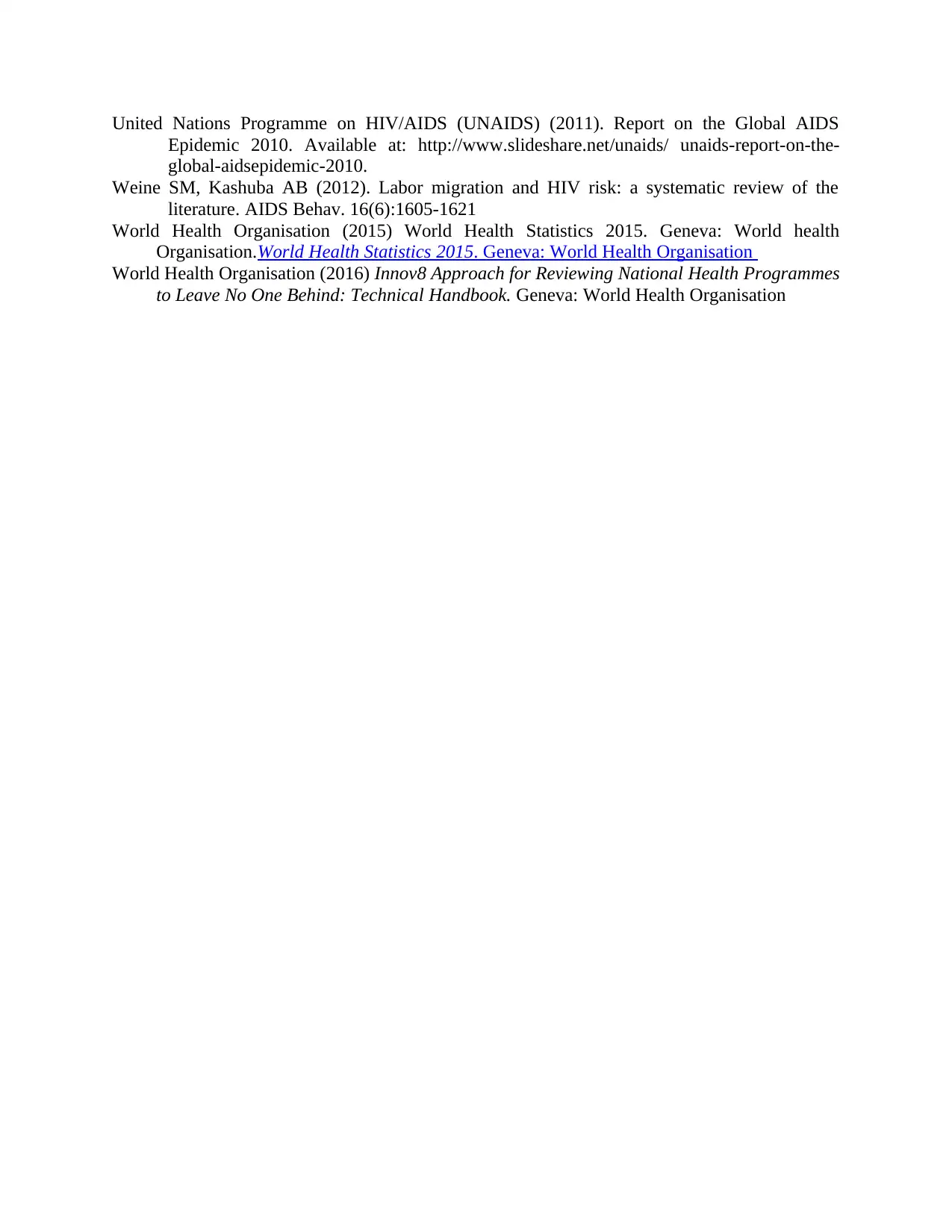
United Nations Programme on HIV/AIDS (UNAIDS) (2011). Report on the Global AIDS
Epidemic 2010. Available at: http://www.slideshare.net/unaids/ unaids-report-on-the-
global-aidsepidemic-2010.
Weine SM, Kashuba AB (2012). Labor migration and HIV risk: a systematic review of the
literature. AIDS Behav. 16(6):1605-1621
World Health Organisation (2015) World Health Statistics 2015. Geneva: World health
Organisation.World Health Statistics 2015. Geneva: World Health Organisation
World Health Organisation (2016) Innov8 Approach for Reviewing National Health Programmes
to Leave No One Behind: Technical Handbook. Geneva: World Health Organisation
Epidemic 2010. Available at: http://www.slideshare.net/unaids/ unaids-report-on-the-
global-aidsepidemic-2010.
Weine SM, Kashuba AB (2012). Labor migration and HIV risk: a systematic review of the
literature. AIDS Behav. 16(6):1605-1621
World Health Organisation (2015) World Health Statistics 2015. Geneva: World health
Organisation.World Health Statistics 2015. Geneva: World Health Organisation
World Health Organisation (2016) Innov8 Approach for Reviewing National Health Programmes
to Leave No One Behind: Technical Handbook. Geneva: World Health Organisation
1 out of 15
Your All-in-One AI-Powered Toolkit for Academic Success.
+13062052269
info@desklib.com
Available 24*7 on WhatsApp / Email
![[object Object]](/_next/static/media/star-bottom.7253800d.svg)
Unlock your academic potential
© 2024 | Zucol Services PVT LTD | All rights reserved.

